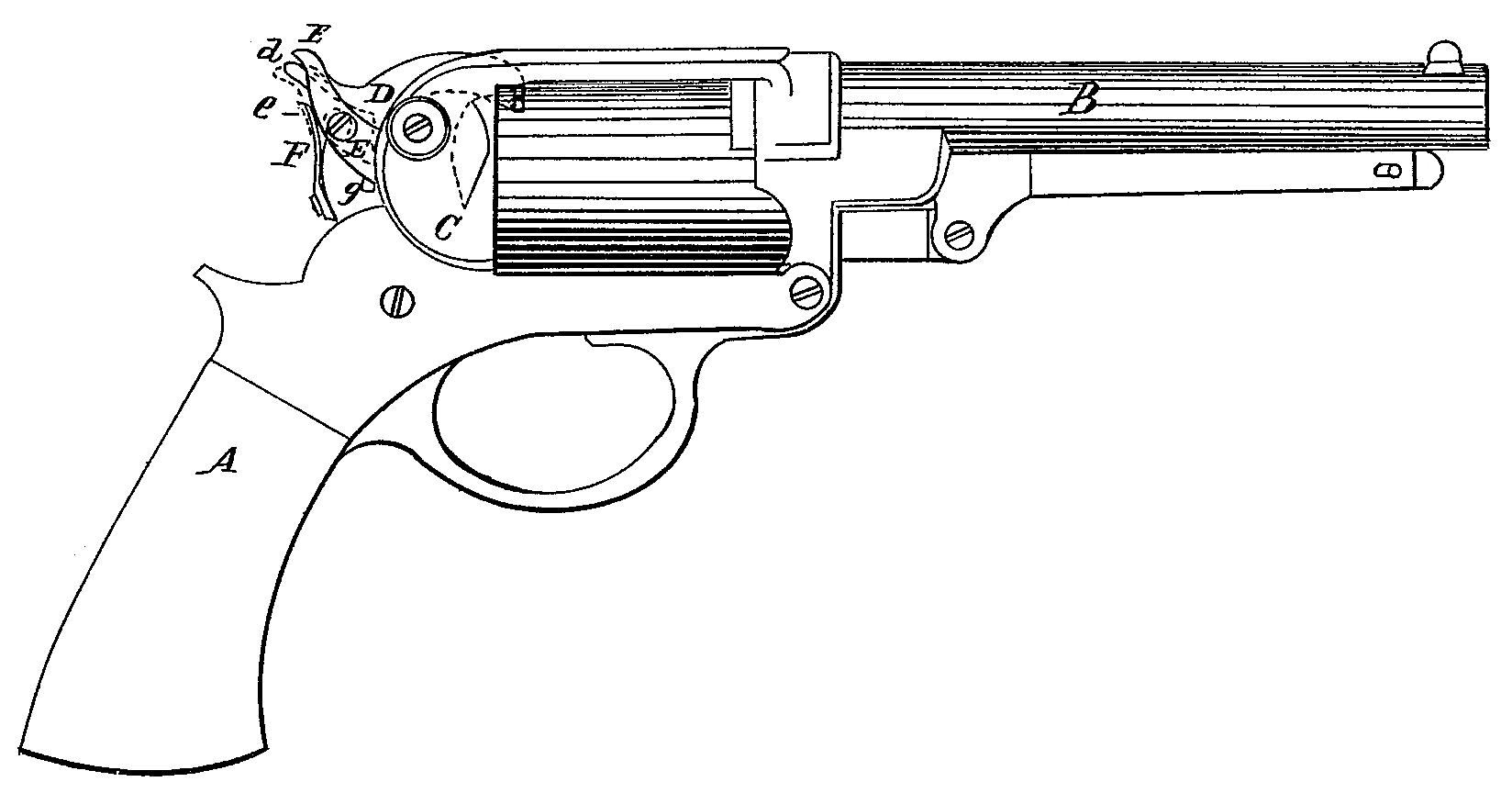US 45532
UNITED STATES PATENT OFFICE.
E. T. STARR, OF NEW YORK, N.Y.
IMPROVED SAFETY DEVICE FOR LOCKS OF FIRE-ARMS.
Specification forming part of Letters Patent No. 45,532, dated December 20, 1864.
To all whom it may concern:
Be it known that I, E. T. Starr, of the city, county, and State of New York, have invented a new and Improved Hammer-Lock for Fire-Arms; and I do hereby declare that the following is a full, clear, and exact description thereof, which will enable others skilled in the art to make and use the same, reference being had to the accompanying drawing, forming part of this specification. Said drawing is a side elevation of the frame and hammer of a revolving firearm, showing the application of my improvement.
The object of this invention is to prevent the hammer of the fire-arm from being accidentally driven or forced against the cartridge or cap, and thus avoid the danger of those premature explosions by which life and limb are so often sacrificed.
My improvement may be applied to almost every description of fire-arm or weapon in which the discharge is accomplished by the fall of a hammer.
It will only be necessary to describe that portion of the fire-arm to which my improvement is to be attached.
A is the usual stock, B, the barrel, and C the frame in which the lock is contained. All of the above parts are constructed in the usual manner.
D is the hammer, made and operating substantially the same as in all fire-arms. d is the horn or thumb-piece by which the hammer is raised.
My invention consists in the combination, with the hammer, of a lever-lock, E, pivoted in any suitable manner to the side or other part of the hammer, and so formed or arranged that said lock is actuated by the pressure of the thumb in the usual act of raising the hammer or the letting down thereof.
e is the pivot by which the lock E is attached to the hammer.
The lock E consists of a thin plate having the general form of the hammer-horn d, at the side of which it is placed. The lower end of the lock E is beveled or pointed, and this point fits into a tooth or depression, f, which is cut in the back of the frame C, as shown.
Behind the lock E, and attached to the hammer, is a spring, F, which bears against the lock E and tends to throw the point of the latter down, so that it cannot engage the tooth f, except when pressure is specially applied to the upper end of the lock E for that purpose.
g is a pin upon the side of the hammer, which forms a stop or rest, against which the lower end of the lock E rests when not in use.
When the hammer is resting upon the nipple or cartridge the hammer occupies the position shown in black in the drawing, the upper end of the lock E being slightly in advance of the horn d of the hammer. If it is now desired to use the lock E to prevent the contact of the hammer with the cartridge or nipple, pressure is applied to the upper end of the lock E, and it is pressed slightly back, and the hammer D is also raised a little, which movement elevates the lower end or part of the lock E, which point is then allowed to fall into or engage the tooth f, and thus to lock or hold up the hammer D, so that it cannot come in contact with the cartridge or cap.
In order to unlock the lock E it is only necessary to lift the hammer D. The ordinary act of cocking the hammer therefore unlocks the lock E and places the arm in readiness for firing.
I have herein referred to the resting of the hammer upon the cartridge or nipple; but in some forms of fire-arms the hammer strikes against a plunger and drives the plunger against the nipple or cartridge, thus producing the explosion. The lock E is of course to be so applied as to prevent the hammer from striking the plunger or whatever other device may be employed to convey the blow of the hammer to the cap or cartridge to effect the firing thereof.
I do not confine myself to the particular arrangement or construction of the lock E here shown, as it may be applied by any skillful mechanic in various ways; nor do I claim broadly the application of locks to fire-arms to prevent the hammer from resting upon cartridge or cap; but,
Having thus described my invention, I claim as new and desire to secure by Letters Patent—
The combination, with the hammer D, of a lever-lock, E, when the said lock is so made and arranged as to be operated by the act of raising or letting down the hammer, substantially as herein shown and described.
E. T. STARR.
Witnesses:
J. P. Hall,
Wm. T. McNamara.

